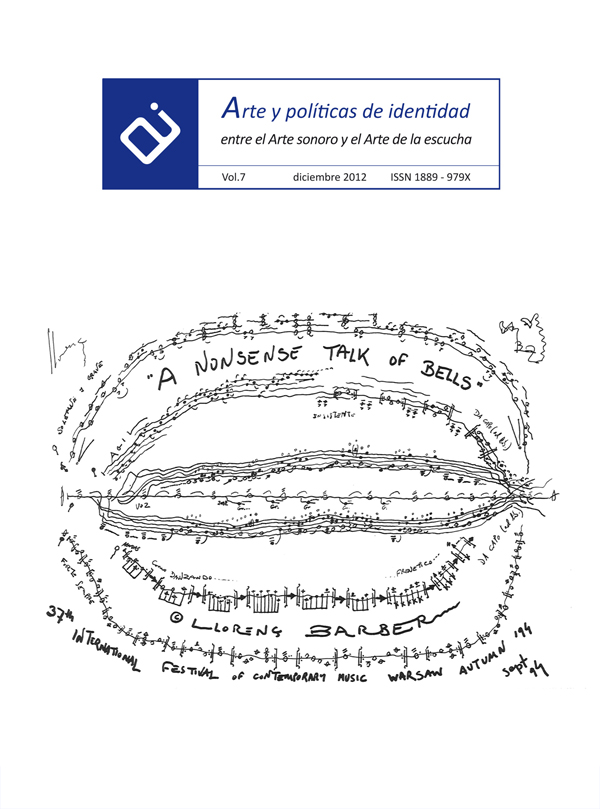The Visual Power of the Loudspeaker: Artistic Projects Regarding the Plastic Dimension of the Loudspeaker as Visual Epicenter Sound-Agent.
Abstract
This article highlights the plastic perspective of technical materials that certain works have established in the field of sound art throughout the twentieth century. The study focuses particularly on the loudspeaker according to the following three aspects: technical, visual and symbolic. To conduct this study, monographs, catalogs, articles and other audiovisual documents were consulted in both analog and digital formats. The conclusion of the analysis has evidenced an order and definition of different methodologies and experiences, as well as the points held in common, that are reflected in artistic practices. The aim of this analysis is not to detail the specifics of the technologies used in the selected works, but to emphasize the poetic perspective and visual reference that they adopt.
Downloads
-
Abstract418
-
PDF (Español (España))401
References
Alsina Thevenet, H. (1974). Vertov, artículos, proyectos y diarios de trabajo. Buenos Aires: De la Flor.
Ariza, J. (2008). Las imágenes del sonido: Una lectura plurisensorial en el arte del siglo XX (2ª edición corregida). Cuenca: Ediciones de la Universidad de Castilla-La Mancha.
Artaud. A. (1983). Para acabar de una vez con el juicio de Dios.Madrid: Fundamentos.
Biedermann, H. (1996). Diccionario de símbolos. Barcelona: Paidós.
Cirlot, J. (1985). Diccionario de símbolos. Barcelona: Labor.
Cotter, H. (1992, 5 de mayo). Jennifer Bolande.The New York Times.
Farabet, R. (2002). Notas al margen de un trabajo radiofónico. Recuperado el 16 de junio de 2012 de http://terredinessuno.com/cterre/paginas/07.html
Flynn, T. (2002). El cuerpo en la escultura. Madrid: Akal.
Gómez, J. (2008). El arte sonoro y el radioarte como géneros artísticos de la contemporaneidad. Recuperado el 26 de junio de 2012 de http://parlante23.blogspot.com/feeds/posts/default
Gómez de la Serna, R. (1928). Elección del altavoz. Revista Ondas, año 4, núm. 175, 20 octubre, p. 6.
Iges, J. (2010). Sobre el Radioarte: reflexiones sin desarrollo. Recuperado el 18 de junio de 2012 de http://www.lear-radioarte.com.ar/TEX/iges.pdf
Martin, S. (2004). Música electrónica y música con ordenador.Madrid: Alianza Música.
Murray Schafer, R. (1969). El nuevo paisaje sonoro. Buenos Aires: Ricordi.
Negroponte, Nicholas (2000). Mundo Digital. Barcelona: Ediciones B.
Nyman. M. (1974). Experimental Music. Cage and Beyond. Londres: Studio Vista.
Polonio, E. (1997). Breve epigramario de meditaciones encadenadas. Academia Internacional de Música Electroacústica, Bourges. Recuperado el 13 de julio de 2012 de http://www.eduardopolonio.com/epigrama2.html
Revilla, F. (1999). Diccionario de iconografía y simbología.Madrid: Cátedra
Works published in this journal are subject to the following terms:
- The Service of Publications from the University of Murcia (publishing house) keeps the published works’ copyrights, and favors and allows the reuse of these works under the license indicated in point 2.
- Works are published in the journal’s online edition under the license Creative Commons Reconocimiento-NoComercial-SinObraDerivada 3.0 España(texto legal). They can be copied, used, disseminated, transmitted and publicly exhibited, as long as: i) the author and original source of publication are cited (journal, publishing house and work’s URL); ii) they are not used for commercial purposes; iii) the existence and specifications of this license are mentioned.
3. Conditions for auto-file. It is allowed and encouraged that authors share electronically their pre-print version (the pre-reviewed version) and /or post-print version (the reviewed and accepted version) of their Works before the publication, since it promotes its circulation and dissemination. RoMEO color: green.










